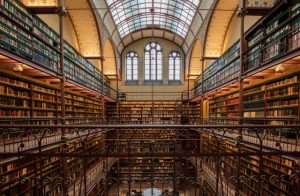Contemporary art is a huge business, with all the trappings of any other business, including marketing, sales and money. Yet it continually surprises us with its lack of logic. Don’t get me wrong. I am not saying there is no logic to contemporary art. It goes without saying that there are some works of contemporary art that are better than others. But what is lacking, as any critic will tell you, is quality control; or rather the ability to predict who will succeed and who won’t.
By this definition, Damien Hirst is an artist of genius. He took the art world by storm in 1995 with his shark in formaldehyde (The Physical Impossibility of Death in the Mind of Someone Living) and has since continued to produce works that sell for millions at auction.
But Hirst has become too big to be a contemporary artist. There are many artists more talented than he is who have slipped into obscurity because they have failed to market themselves as well as he has. Hirst’s career moves with a logic all its own: his success is built on his capacity to generate publicity for himself and his work through stunts like making his own death mask or touring the country in a truck filled with medicine cabinets full of prescription drugs — both of which were part
There are a few types of contemporary art that are reasonably stable over time. In two of them, the art objects get sold, which helps keep their value roughly stable. In the other two, the art objects either don’t get sold or don’t stay in one place long enough to appreciate.
Art objects that get sold include paintings and sculptures by established artists. The value of these tends to go up slowly but steadily over time. For most artists, this is as much as you can hope for. They make a living selling their work and then they die.
But there are also a few contemporary artists whose work gets more valuable over time. This is because they produce something like the way Picasso did: they do new things that change how people think about art and then other artists copy those new things and then those new things become familiar and people expect them from artists who want to be considered seriously, and so on until eventually everyone agrees that whatever it was they were doing is now a style and then it becomes retrograde not to use that style if you want to be considered serious, at which point the cycle begins again with them being copied by younger artists, which drives up their prices even further.
The problem for contemporary artists is that this process can take decades or
Contemporary art is a huge industry, supported by the world’s wealthiest collectors. It is also becoming increasingly mainstream and widely recognized. But this isn’t necessarily a good thing—just take a look at the state of modern books, fashion, and pop music.
Contemporary art has become a huge business. In many ways, it is like any other major industry. The value of their work is determined by how much money people are willing to pay for it. Artists are now celebrities, selling their works for enormous sums of money in auctions around the world. One artist sold his work for $110 million in 2013 alone.*
Many artists make what you might call “conceptual art,” which means that they don’t create anything tangible at all, but instead use their work to express an idea or theme. In order to be considered art, there are no limitations on what can be created or displayed—it just needs to have the right intention behind it. Some people feel that contemporary art has become too focused on the process rather than the result. Whatever the state of its underlying values, contemporary art is clearly popular these days; museums and galleries are packed with visitors and exhibitions sell out quickly as collectors rush to get their hands on new pieces.”
**The above passage was
I think that the performance of contemporary art is a good way to examine how our society is changing.
It’s hard to say what’s a good example of contemporary art. A film, photo or painting could be considered a piece of contemporary art but so can a book, essay, sculpture, installation or performance. I’ll try to look into some examples that I find interesting and illustrate my point.
Tate Modern in London is one of the best places in the world to find pieces from all over the world in one place. Last year they included work by Marina Abramovic, who is known for doing extreme performances. Her work looks at boundaries that we have between ourselves and others. One performance she did was called ‘Cleaner’ where she invited people to sit opposite her while she did mundane tasks like folding laundry and cutting carrots until the gallery closed. Some people were invited back more than once as Abramovic felt an intense connection with them. She says ‘the longer I look into someone’s eyes, the more I feel that he becomes part of me.’
When I was there there was another artist called Yilmaz who made bronze seats with no backs on them with people’s names engraved on them and placed them around Tate Modern with little plaques explaining why they
Contemporary art is often interpreted as an extension of modernism. But while they are both concerned with the meaning and value of images, the differences between these two periods cannot be overlooked.
What is contemporary art? The concept of contemporary art is complex, and its definition has shifted over time. It is commonly used to refer to any art created in the past 50 years, although it can also be used in reference to art created within a certain cultural context or period, or even simply referring to works created using new media or new techniques.
The concept of contemporary art emerged in the twentieth century as a loose equivalent to modernism. Since then, it has been used to describe new movements and trends that have developed since World War II – for example abstract expressionism, pop art, performance art and minimalism.
The term can also be used more broadly – for example to include nineteenth-century movements such as impressionism and post-impressionism, which are also sometimes included in modernist studies. Some would argue that all historical eras are contemporary.
While some artists reject the label of ‘contemporary’ altogether, others embrace the term and define it themselves. For example, in a 1996 interview with Andrew Graham-Dixon for The Independent newspaper, Damien Hirst



